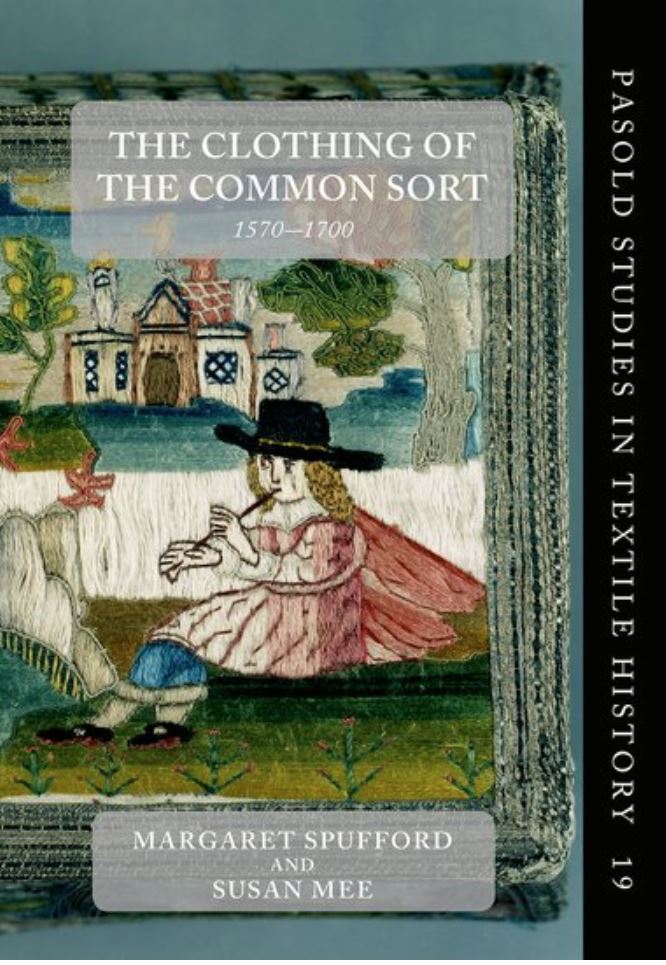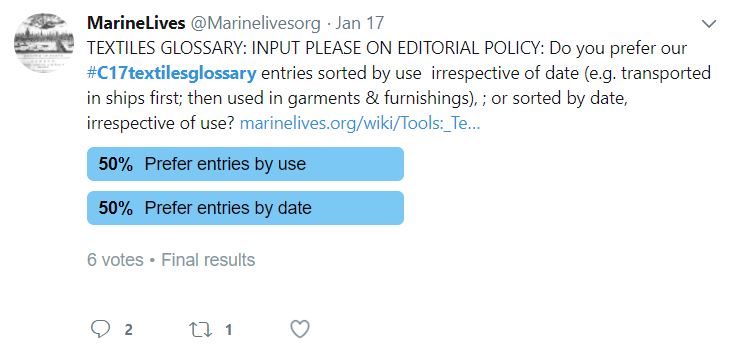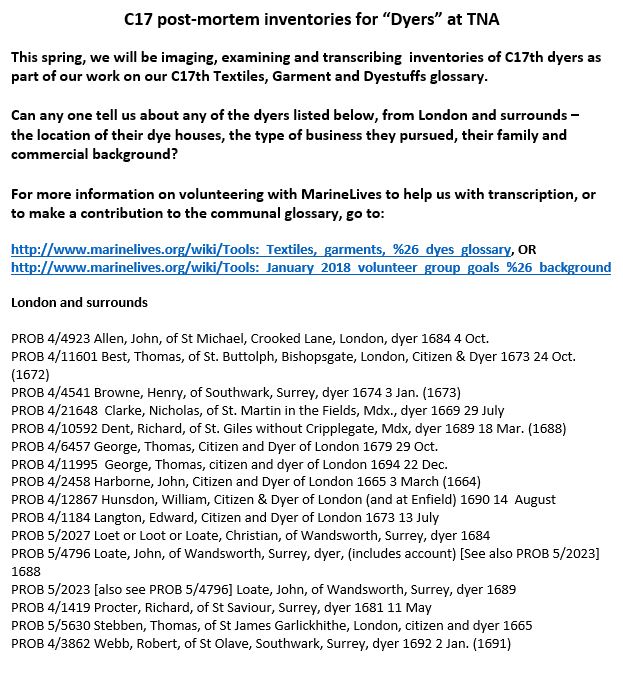Tools: Textiles, garments & dyestuffs glossary sub-group
Texiles, garments & dyestuffs glossary sub-group
Contents
What is the C17th Textiles, Garments & Dyestuffs glossary sub-group?

Purpose
We have formed a sub-group of MarineLives volunteers to work on our communal C17th textiles, garments & dyestuffs glossary - establishing policies, adding terms, researching new entries, and working with our active Twitter and wiki readership to solicit new soures and commentaries.
The glossary was established on December 24th, 2017. It is a primary source based web resource, and is being developed from early and mid-C17th English High Court of Admiralty documents, second half of the C17th Chancery Court documents relating to commercial disputes, second half of the C17th Prerogative Court of Canterbury merchants' inventories, and a London coastal portbook from the 1650s.
The terms are referenced to primary manuscript sources, typically linked to manuscript images and full text transcriptions. As of 18/01/2018, the glossary contains ca. 1000 terms.
Contributing to the glossary
We are using the @Marinelivesorg Twitter account to solicit new commentary and edits on specific terms, which we are incorporating into the glossary. We will acknowledge all contributions, but reserve the right (with the agreement of contributors) to make small editorial changes. Recent tweets related to the glossary can be found at #C17textilesglossary
Issues for discussion
- What specialist knowledge and skills do we have amongst members of this sub-group related to textiles, garments and dyestuffs?
- Are there particular topics individuals wish to focus on?
- How shall we allocate work on a weekly or bi-weekly basis?
- Should we form an editorial group?
- Should we develop more formal editorial standards?
- Should we include references to use of terms in the glossary outside C17th (both earlier and later)?
- How should we establish new manuscript sources for the period 1627-1677, related to the themes of the glossary, and ideally to MarineLives, which we can image and transcribe as new sources for the glossary?
Open questions
Questions and chat about specific items and processes may be found on the Glossary's Discussion page.
Potential new primary sources for the glossary
Port Books
Communication from Peter Taylor to Colin Greenstreet, 20/01/2018
"In terms of which Port Books you might want to photograph and transcribe you are really spoilt for choice for London Port Books in your period. Survival rates for the Civil War period are much higher than at most other ports so the 1640's would be of considerable interest. London had more customs officials than anywhere else so consequently more Port Books to complete each year. You need to decide what type of information you want in order to select the correct officials' account e.g. if you want to know descriptions and quantities but are not interested in values then the Surveyor or Searcher accounts are generally the fullest as they were based on a physical inspection of the laded goods. Wool and leather goods had their own separate books as did those goods subject to the New Impositions. Aliens also had their goods recorded in separate accounts. Coastal books do not feature money except that some mention the amount of the bond the master / merchant had to enter into as surety against export. Occasionally they mention why the certificate attesting to the coastal delivery of the goods was not available (lost, plague or shipwreck). Recording practises varied enormously between ports, e.g. Bristol did not record any inwards coastal trade and the lack of financial interest meant that some Coastal Port Books give a less than complete view of trade. This seems to vary enormously from commodity to commodity depending on the incentives to trade illicitly.
In terms of merchant status they are normally listed as indigenous, alien or denizen although often Scottish or Irish merchants are listed as such rather than as alien. Although outside my period, you sometimes see entries listing a merchant as "ind et ali" which I think refers to the Navigation Acts which required a certain percentage of the crew to be English so the entry is recording the presence of both English and foreign crew. (I will need to double-check this).
In terms of importance, note that there are no other trade statistics available between the farming of the Customs by James I and the setting up of the Board of Trade, therefore the C17th Port Books are particularly important if you want to try and value England's import and export trade. You also need to be aware that valuations are notional based on the Book of Rates in force at the time with only un-listed items having "real" values based on a merchant's declaration on oath. In my case, tobacco pipes have "real" wholesale values only prior to 1635. This can work in your favour if you can read a valuation in the Port Book but the quantity is illegible - you can work the calculation backwards."
Dyers inventories
Sub-group membership
Dr Kimberly Alexander
Freyalynn Close-Hainsworth
Nicola Clarke
Paula Marmor
Dr Susan Mee
Existing glossary contributors
Dr Kimberly Alexander, Dr Aaron Allen, Dr Carolyn Arena, Cynthia Chin, Nicola Clarke, Freyalynn Close-Hainsworth, Eglantine, Dr Karwan Fatah-Black, Helen Good, Colin Greenstreet, Tracey E Griffiths, Viveka Hansen, Dave Henderson, Dr Stefan Hessbrüggen-Walter, Jeffrey Hopper; Heather Knight, Dr Marcin Krygier, M.L. Logue, the pseudonymous Mapnut, Dr Angela McShane, Paula Marmor, Dr Susan Mee, Menno Jonker, Angela Middleton, Frances Owen, Tim Parry-Williams, Dr Michael Pearce, Elizabeth Pimblett, Dr Sophie Pitman, Mark Ponte,Dr Jo Pugh, Dr Deborah Sherlock, Dr Stephen Snelders, Ian Stoll, Peter Taylor, Dr Samantha Thompson, Rebecca Unsworth
Today's featured new glossary entry

